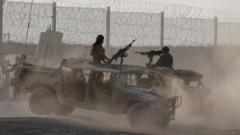A new aid distribution system in Gaza, backed by the US and Israel, has been marred by chaos, with reports of violence and inadequate support for hungry residents as they struggle to receive essential supplies.
Aid Chaos Unfolds in Gaza Amid New US-Israeli Backed Initiative

Aid Chaos Unfolds in Gaza Amid New US-Israeli Backed Initiative
The launch of a controversial aid distribution scheme by the Gaza Humanitarian Foundation has led to disarray and unrest among desperate locals.
The scene was at first filled with hope and camaraderie as a security contractor gestured to a crowd of eager Palestinians at the newly opened aid distribution center, marking what many hoped would be a vital food supply initiative. Yet, as the day progressed, that initial cheer swiftly devolved into pandemonium. Videos captured the moment when the jubilant crowd transformed into a chaotic throng, desperately pushing against fences and overwhelming the barriers, amidst the sound of gunshots echoing through the air.
This tumultuous beginning was part of a contentious new program launched by the Gaza Humanitarian Foundation (GHF), an organization established with the support of the US and Israel to provide food aid in Gaza. The region has been heavily impacted by an Israeli blockade that has left over two million Gazans facing starvation, according to the United Nations. While GHF aims to deliver aid outside the purview of traditional NGOs, it has faced backlash and boycotts from various humanitarian organizations, emphasizing the scale of the crisis on the ground.
Throughout its first week, GHF claimed it aimed to distribute meals to one million Gazans at four strategically located sites. However, as of the fourth day, reports of only two million meals being provided raised skepticism about the effectiveness and efficiency of this operation. Footage from distribution sites depicted disturbing scenes of panic as projectiles exploded near civilians, further exacerbating their fear and anxiety.
In the aftermath of looting incidents at aid warehouses, the GHF issued strict warnings to locals about any future disturbances and closed sites deemed unsafe. However, the broader operation has struggled with organization and communication, leaving many residents in confusion and heightening the tension on the ground. Misleading information circulated online, further complicating efforts to disseminate critical updates about aid availability.
Organizations from Oxfam to local observers have raised concerns regarding the particular setup of GHF’s distribution approach, which is deemed to facilitate military control over humanitarian aid. Critics highlight that the limited number of sites hinders access for vulnerable populations and increases the risks associated with obtaining food supplies. There were previously over 400 distribution points managed by the UN.
As GHF continues its operations amid heavy security, experts worry that such oversight might erode the trust necessary for effective humanitarian work. The organization maintains it is positioned to deliver essential assistance while acknowledging its tightrope act of operating under duress.
In the face of ongoing food insecurity, many Gazans are left disheartened and empty-handed, as hope continues to flicker amidst chaos and uncertainty in a region starved for help.



















